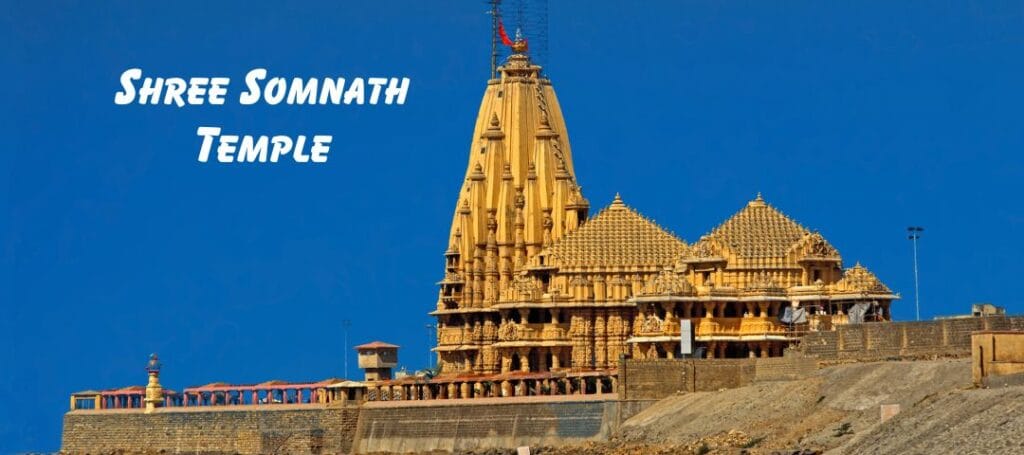Somnath Temple is located in the Gir Somnath district of Gujarat, in the Prabhas Patan area. It is considered the oldest of the 12 Jyotirlingas in the world. The temple is located strategically on the coast of the Arabian Sea.
The Somnath Temple has held a special place in the history of South Asia and especially India since times immemorial. This is one temple that has been plundered, destroyed, and looted 17 times but the faith of Indians has withstood the testimony of time. Every time the temple was rebuilt, it became bigger and grander. Throughout history, royals and commoners have given their lives to keep the legacy of this temple alive.
The temple is located strategically on the Arabian Sea coast at the confluence of Kapila, Hiran and Saraswati rivers. Know more here.
How to Reach the Somnath Temple
- By Air: The nearest airport to Somnath Temple is the Diu Airport (approximately 80 kilometers away). You can take a flight to Diu from major cities like Mumbai or Ahmedabad and then proceed to Somnath by road.
- By Train: Veraval Railway Station is the nearest railway station to Somnath, located just 6 kilometers away. Veraval is well-connected by trains to major cities like Ahmedabad, Mumbai, Delhi, and others. From Veraval Railway Station, you can hire a taxi or take a bus to reach Somnath Temple.
- By Road: Somnath is well-connected by roads to various cities in Gujarat and neighboring states. You can reach Somnath by state-run buses, private buses, or by hiring a taxi or cab. The temple is easily accessible from major cities like Ahmedabad, Rajkot, Junagadh, and Porbandar.
- From Ahmedabad: If you’re traveling from Ahmedabad, you can either drive down to Somnath, which takes around 7-8 hours, or take a bus from Ahmedabad Central Bus Station (Geeta Mandir) to Somnath. There are regular bus services operated by Gujarat State Road Transport Corporation (GSRTC) as well as private operators.
- From Mumbai: If you’re coming from Mumbai, you can either take a train to Veraval or a flight to Diu, followed by a taxi or bus journey to Somnath.
- Local Transportation: Once you reach Somnath, getting around the town and visiting the temple is easy. You can hire auto-rickshaws, cycle-rickshaws, or taxis for local transportation.
Before planning your trip, it’s advisable to check the current transportation options and schedules, especially if you’re traveling during peak seasons or festivals. Additionally, consider booking your accommodation in advance, especially if you’re visiting during a busy time.

History of Somnath Temple
The Somnath Temple’s history can be traced back to antiquity, with references to a shrine dedicated to Lord Shiva at the site dating back to ancient texts like the Skanda Purana. The temple is believed to have been originally built by the Moon God, Soma, to rid himself of a curse.
The temple gained prominence during the reign of the Solanki dynasty in the 10th century. It became a significant pilgrimage site and a center of religious and cultural activities. Throughout its history, the Somnath Temple faced numerous invasions and destructions by foreign rulers. It was destroyed and rebuilt several times between the 7th and 15th centuries.
The most infamous destruction of the Somnath Temple occurred during the invasion of Mahmud of Ghazni, a Turkic ruler from Afghanistan, in 1026 AD. Mahmud’s forces looted the temple, destroyed its idols, and plundered its wealth. Despite the repeated destruction, the Somnath Temple was rebuilt by Hindu rulers and devotees each time. It symbolizes the resilience and unwavering faith of the Hindu community.
The current structure of the Somnath Temple was rebuilt in the 20th century, post-independence, under the patronage of Sardar Vallabhbhai Patel, the first Deputy Prime Minister of India, and with the efforts of the Indian government. It was inaugurated on May 11, 1951.
The Architectural Marvel of Somnath Temple
The main sanctum sanctorum of the Somnath Temple houses the Shiva lingam, the symbol of Lord Shiva. The lingam is placed in a sacred chamber known as the garbhagriha. The temple structure is built using stone blocks, and the walls are adorned with sculptures and carvings.
The temple complex features an impressive entrance gate, known as the Mahapravesh dwar, which is adorned with intricate carvings depicting mythological motifs and scenes from Hindu scriptures. The entrance gateway of the temple complex is embellished with gopurams (ornate towers) adorned with sculptures and carvings. Once you enter, there are long lines with railings and roof, where devotees wait patiently for hours for darshan.
The temple complex includes a large mandapa (assembly hall) where devotees gather for prayers and rituals. The mandapa is supported by intricately carved pillars, each depicting scenes from Hindu mythology. The main shrine is at the center, surrounded by various auxiliary shrines, mandapas, and other structures arranged in a symmetrical layout.
The Best time to Visit the Somnath Mandir
The Somnath Mandir is a popular pilgrimage and hence witnesses huge crowds daily. However, crowds are at their peak on Mondays, weekends, and festivals like Mahashivratri. I visited 2 days before Mahashivratri and could complete my visit in only half an hour.
To know about the details visit timings on this website
Important Points to Remember if you are visiting Somnath Temple
Are Mobiles and Bags Allowed in Somnath Temple?
No, Mobiles are not allowed in the Somnath Temple premises. Once you reach the temple vicinity, there is a car parking area. Once you cross that, you will arrive at a temple Dwar or Gate. To the left-hand side of the gate, you will find an elaborate locker facility where you will need to deposit your bags including ladies’ handbags, wallets, sling bags, and mobile phones.
Mobile phones and cameras are strictly prohibited from being taken inside the temple premises and a thorough security checking is done to ensure you do not carry the same. Any kind of eatables and water is also disallowed inside temple premises.
Are Western Clothes allowed inside the Somnath temple?
Yes, western clothes are allowed. However, this being a religious place, it is best to keep religious sentiments in mind before reaching here.
If you are looking for options in Kashmir, check out my posts on Pahalgam, Gulmarg, Snowfall in Kashmir, and Best time to Visit Kashmir. If you are looking for options in Ladakh, check out Ladakh Weather, Nubra Valley, 5 Days Kashmir Itinerary, Best Packing tips for Ladakh & best tourist places in Ladakh.
If you are looking for something in Sikkim, check Tsomgo Lake.
If you are looking for places to visit in the Andaman Islands, please check my post on Radhanagar Beach & Ross Island.If you are looking for some jungle safari read, Gir Safari, or Bandipur Safari, feel blessed at Sri Venugopala Swamy Temple in Mysore.
If you are looking for other seaside options, check my posts on Murud Janjira, Kashid, Pirwadi Beach, and Kihim Beach in Maharashtra, Budget Matheran Resorts or Malshej Ghat. Alternatively, if you are interested in some Religious tourism, please check my posts on Golden Temple, Kamakhya, Trimbakeshwar, and Kashi Vishwanath. If you are looking for North East Adventure tours, check my posts on Shillong, Meghalaya, Dawki, Double Decker Living Root Trek, and 7 Day North East Itinerary. You can also check out my post on Best Places to Visit Mahabaleshwar.
If you are looking for some spirituality, you can check out Ganga Aarti in Dashashwamedh Ghat or Ghats in Varanasi. Check out my posts from South India Sri Venugopala Swamy Temple, Bandipur Safari, and Mandalpatti Peak.


13 thoughts on “Somnath Temple – 5 Things To Know Before You Visit”